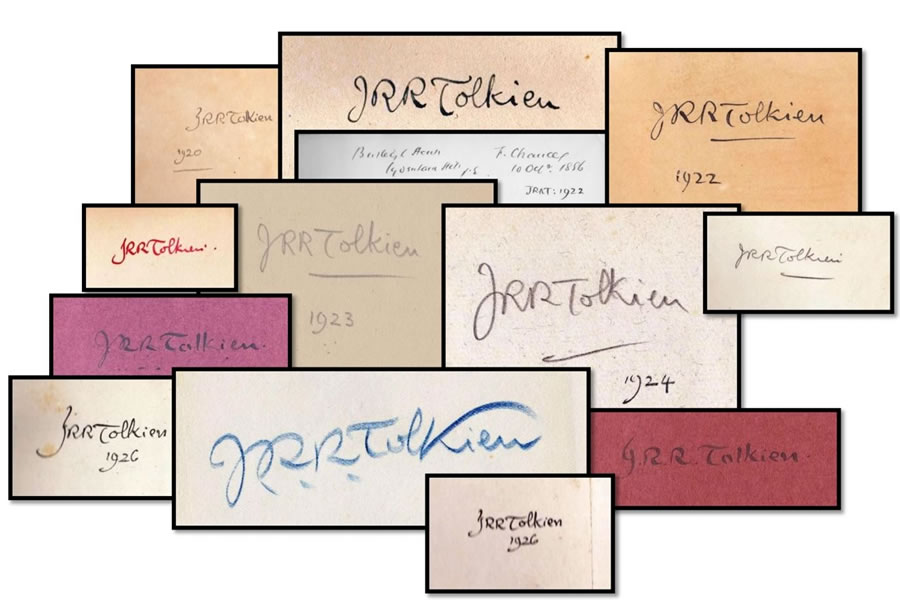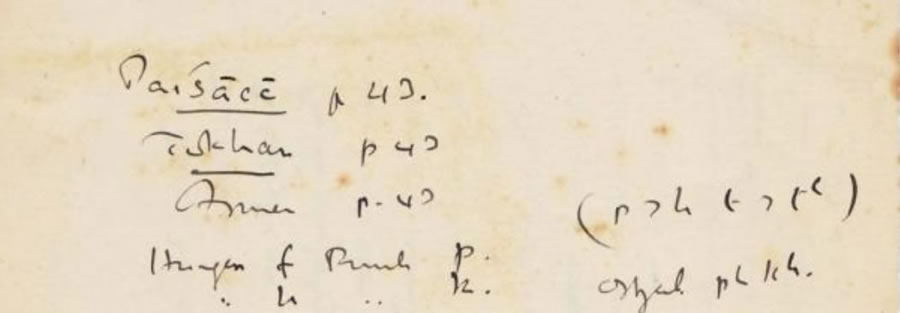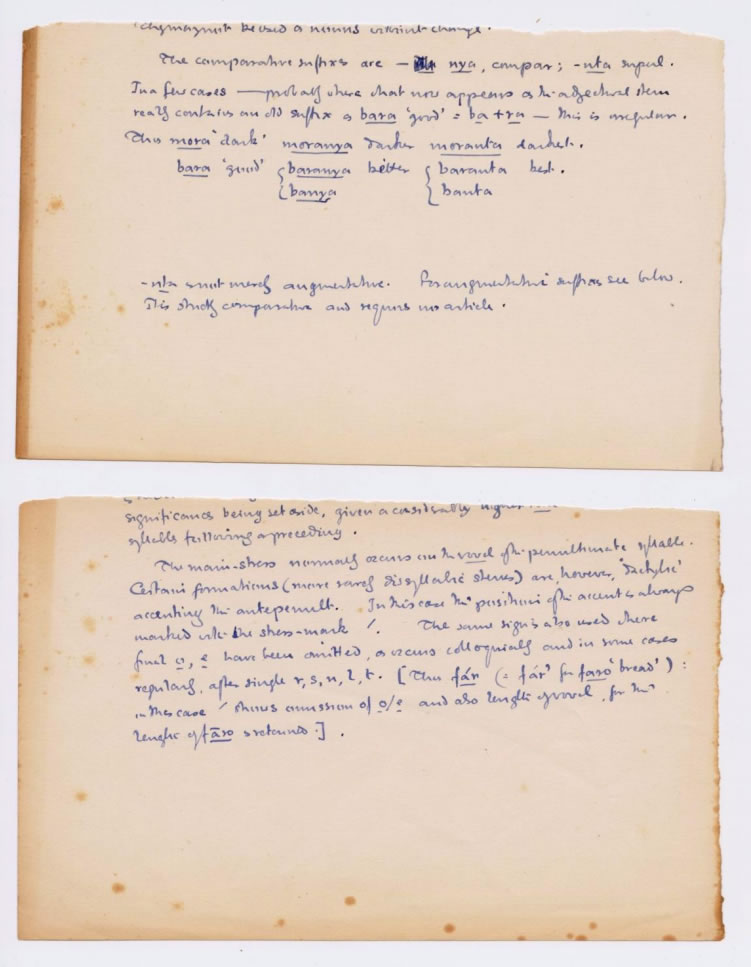Sixteen Philological Books and Notes from the Library of J.R.R. Tolkien (30.12.12 by Madeline J. Keyser) -
Comments
Fifteen of the books are inscribed with tolkien's name and date, and he has annotated some of them (for a full list of these books, see Appendix). They focus on linguistic aspects of the Proto-Indo-European (referred to in the texts as das Indo- Germanisch) language, or its daughter languages, primarily those of the Germanic language family.
Because Tolkien developed a passion for languages at a very young age and spent so much of his time learning, researching, and 'creating' languages, there can be no doubt that there was overlap between his life as an Oxford don and his life as an author of popular fiction. However, scholarly research pertaining to the influence of tolkien's academic work on his fiction focuses primarily on his incorporation of linguistic details from languages such as Old English, Old Norse, Finnish, and their mythologies, especially Beowulf, Das Niebelungenlied, and the Kalevala. These sixteen books have not been accessible since his library was broken up after his death. Thus, little research has been done on the influences, if any, that Indo-European and its daughter languages had on his creative writing. Although research is still in its preliminary stages, tolkien's books and notes should prove a fruitful source for further investigation.
tolkien's Notes and their Connections to the Books from his Personal Library
Not only are tolkien's books in German, but many of his note fragments are difficult to decipher. A comparison of these notes with his letters, such as those to Rayner Unwin (April 30, 1952) and to Mrs. George Sayer (August 10th, 1952), shows that they were not intended for anyone but himself: his handwriting is much more difficult to decipher in the notes than in the letters. Fortunately, the longest and most complete set of notes is the easiest to read (henceforth referred to as Fragment 19. (1))
These notes refer to several of the Germanic linguistic books he used in his academic research. He has two headings in the text: Indogermanen und Germanen: Ein Beitrag zur europäischen Urgeschichtsforschung (2) and Germanen und Kelten in der antiken Überlieferung. (3) Both are books by Sigmund Feist, the distinguished scholar of Germanic linguistics. There is a marginal note in Fragment 19 referring to "Beiträge zur Geschichte d[er]. deutschen Sprache u[nd]. Literatur, vol. 36 x 364." In this journal (originally published in 1910) there is a relevant article by Feist entitled "Die germanische und die hochdeutsche Lautverschiebung sprachlich und ethnographisch betrachtet." (5) Tolkien has also made a note about "Jespersen," in the margin, apparently a reference to Otto Jespersen's book, Phonetische Grundfragen, now part of the Cushing Collection.
tolkien's Research on Sound Change
Although the majority of the notes about Feist's book are unclear, Tolkien quotes a paragraph from Indogermanen und Germanen: Ein Beitrag zur Europäischen Urgeschichtsforschung (see below) and gives the page number from which he drew the information, giving context and a general idea about the focus of his interest. He quotes:
Vollends im Unklaren bleiben wir über den Grund, weshalb das Urgermanische die indogermanischen Medien zu Tenues verschoben hat, obwohl es doch stimmhafte Verschluβlaute besaβ, die wenigstens teilweise (Wortanfang, nach Nasalen usw.) an die Stelle der indogermanischen aspirierten Medien (bh, dh, gh) traten. (6) (Feist, Indogermanen und Germanen, 59).
In tolkien's notes he has added the letters "b," "d," "g," to Feist's list of the mediae aspiratae, i.e. aspirated voiced stops (Tolkien, Fragment 19). His responses to Feist's text show him engaging with the text and drawing from many different grammatical and linguistic sources. Feist's article, "Die germanische und die hochdeutsche Lautverschiebung sprachlich und ethnographisch betrachtet" discusses the Germanic and High German sound shift from a linguistic and 'ethnic' point of view. Feist discusses the causes of sound shifts, primarily the first Germanic sound shift, or Grimm's Law. He focuses on the effect that language contact had on the Germanic sound shifts and offers several theories as to the nature of this contact, including the possibility of their being pidgin languages and inter-marriages between multiple groups of different people. Feist also makes reference to several books that were in tolkien's library (now in the Cushing collection, including Laut- und Formenlehre der Altgermanischen Dialekte. Zum Gebrauch für Studierende dargestellt), and he mentions the influential scholars Wilhelm Streitberg and Eduard Sievers, whose books, Die Erforschung der indogermanischen Sprachen. Band 2: Germanisch and Grundzüge der Phonetik zur Einführung in das Studium der Lautlehre der Indogermanischen Sprachen, were also owned by Tolkien.
His notes on Feist's Germanen und Kelten in der antiken Überlieferung, are virtually illegible. The title of the book itself suggests that he is interested in language contact as a phenomenon, particularly between Germanic and Celtic.
A slightly more legible fragment discusses sound shifts and language contact. He lists three languages, "Paiśācī" (an Indian dialect), "Tokhar" (Tokharian), and "Armen" (Armenian). He has also written "(p > ht > t')...p < kh," and "p 43" next to all the names. (Tolkien, Fragment 18). These references are to page forty-three of Indogermanen und Germanen. Feist is again discussing sound shifts (that is, "p" becomes "h" and "t" becomes aspirated "t" as an example of a sound shift in Armenian) in different languages (Feist, Indogermanen und Germanen, 43).
Thus, he makes a similar point to that made in Beiträge zur Geschichte der deutschen Sprache und Literatur, and mentions that the Armenians must have had language contact with another race to bring about the shift in their language.
Indo-European Grammar and Grimm's Law
Tolkien annotated many of the volumes in Hermann Hirt's seven-volume set Indogermanische Grammatik. In the first volume, Indogermanische Grammatik: Einleitung. I. Etymologie. II. Konsonantismus, (7) Tolkien heavily annotated chapter twenty, "Die Lautverschiebung." (8) In these annotations, Tolkien actually corrects Hirt on what he has to say about Grimm's Law. This is, apparently, a subject about which Tolkien feels very passionately -- parts of his annotations read: "probably wrong," "most unlikely!" and "nonsense!" (Hirt, 221- 222 and annotations).
tolkien's Research and Academic Work
Although tolkien's handwriting cannot always be read word-for-word, enough can be drawn from these notes to show that Tolkien was investigating sound shift in language, and how contact (and the type of contact) between two languages may affect the development of each language. These notes appear to be lecture or essay notes, possibly for the lectures Tolkien gave at Oxford on Thursdays at 12:00 p.m. in the Examination Schools during the 1935 Trinity Term, entitled "Grimm's Law" (Scull, Hammond 177). Given tolkien's knowledge of Germanic philology, allusions to sound shift in his mythology are not surprising.
The Influence of tolkien's Scholarship on his Legendarium
Tolkien claims that there were systematic changes in the Elvish languages in The Silmarillion, as a result of which the Sindar could no longer fully communicate with the the Noldor when reunited. When they first "awoke," all the Elves spoke Quenya. Tolkien never describes in detail the original language of Elves. According to Elizabeth Solopova, it was portrayed as a proto-language (81), but the version of Quenya used in The Silmarillion represents the language as it was spoken by the Elves in Valinor. Later, when the Noldor were exiled, "[t]his language was brought to Middle-Earth...but abandoned by them as daily speech" (Tolkien, Silmarillion 346). The Sindar spoke Sindarin, which was also "derived from the common Elvish speech but greatly changed through long ages from Quenya of Valinor" (Tolkien, Silmarillion 348). Thus, with these shifts in language, they came to speak essentially two different languages. Once they resumed contact with one another, they "became welded into one people, and spoke the same tongue" (Tolkien, Silmarillion 117). The Noldor took up the Sindarin language, with Quenya becoming a kind of a lingua franca; an "Elven-Latin, [that was] still used for ceremony, and for high matter of lore and song" (Tolkien, Lord of the Rings Appendix F 1101). Tolkien does not go into detail about specific developments in the two languages, but he tells the reader that, in Lόrien, Sindarin was spoken "with an 'accent,' since most of its folk were of Silvan origin...but [the names] Lόrien, Caras Galadhon, Amroth, Nimrodel are probably of Silvan origin, (9) adapted to Sindarin." (Tolkien, Lord of the Rings Appendix F 1101). Elizabeth Solopova further describes this systematic language creation when she points out that Tolkien often built similarities into the phonology, vocabulary, and grammar of Noldorin and Sindarin, and explained these similarities through the common origin of the two languages and their gradual divergence through change and accumulation of individual features...the form of names takes into account the relationship between Quenya and Sindarin, and the existence of parallel, similar but not identical, Quenya and Sindarin forms. (Solopova 81).
It is clear that the contact among the two groups of Elves did not leave either language unchanged, a result that exactly mirrors the kinds of change with which Tolkien was familiar in diverging Germanic languages.
Tengwar Alphabet
A connection can also be drawn between Otto Jespersen's book, Phonetische Grundfragen, and tolkien's mythology. In the chapter "Lautschrift," (phonetic transcription), Jespersen discusses a hypothetical ideal alphabet, in which a writing system could be adjusted to represent every sound in every language, because spelling, or even an individual letter, cannot always exactly represent pronunciation (Jespersen 14). Tolkien agrees with Jespersen on this obvious point, and he describes the traditional alphabet as a "haphazard series of letters, each with an independent value of its own, recited in a traditional order that has no reference 8 either to their shapes or to their functions" (Tolkien, Lord of the Rings, Appendix E 1093). He appears to have taken it upon himself to create this ideal alphabet. The Tengwar letters can be adjusted to reflect the location of the pronunciation of a particular letter. He describes this system as a "system of consonantal signs" rather than an alphabet, that could be "adapted at choice or convenience to represent the consonants of languages observed (or devised) by the Eldar” (Tolkien, Appendix E 1093).
Note Fragments
Mora seems to be of North (Scandinavian) and West Germanic origin -- the Latin root is found in Modern English words such as murky, and in other Germanic words associated with darkness.
This connotation appears to have influenced a word root seen quite often in The Lord of the Rings -- "mor." According to a draft letter from Tolkien to a Mr. Rang in August of 1967, the root "mor" means "dark, black, seen in Mordor, Morgoth, Morannon, Morgul etc...*mori 'dark(ness)' = Q[uenya] more, S[indarin] môr...S[indarin] morn 'dark'."(Carpenter, Letters 382-383). Tolkien seems to have been drawn to mor and its association with darkness.
In another fragment, Tolkien notes the position of stress and accent in the words faro and fár'. In this instance, the stress mark is used to indicate a missing 'o' in colloquial speech, and that the 'a' retains its length, even when the 'o' is omitted.
Here Tolkien glosses 'faro' 9 as 'bread,' but it appears to derive from the Latin word 'farina,' a type of wheat found in the East.
Footnotes
(1) This is the number by which this particular note fragment is catalogued at Cushing Library
(2) Indo-Germanic and Germanic: A Contribution to the Research of European Prehistory
(3) Germanic and Celtic in Ancient Lore
(4) Contributions to the History of Germanic Language and Literature
(5) The Germanic and High German Sound Shift from a Linguistic and Ethnic Point of View
(6) "We are still unsure of the reason for the occurrence of the Indo-Germanic shift from media to tenuis, even though it still has features of a voiced closed phoneme, at any rate, which partially (at the beginning of a word, after nasals, etc.) replaced the Indo-Germanic aspirated mediae (bh, dh, gh)." (My translation).
(7) Indo-Germanic Grammar: Introduction. I. Etymology. II. Consonantism
(8) The Sound Shift
(9) The Silvan Elves, also called Woodland Elves, "appear to have been in origin those Nandorin Elves who never passed west of the Misty Mountains, but remained in the Vale of Anduin and in Greenwood the Great" (Tolkien, Silmarillion, 348).
Works Cited
Carpenter, Humphrey, and Tolkien, Christopher, eds. The Letters of J.R.R. Tolkien. New York: Houghton Mifflin, 2000. Print.
Feist, Sigmund. Indogermanen und Germanen: Ein Beitrag zur Europäischen Urgeschichtsforschung. Halle: Max Neimeyer, 1924. Print.
---. "Die germanische und die hochdeutsche Lautverschiebung sprachlich und ethnographisch betrachtet." Beiträge zur Geschichte der deutschen Sprache und Literatur 1910.36 (1910): 307– 354. Web. 17 July 2012.
Hirt, Hermann. Indogermanische Grammatik: Einleitung. I. Etymologie. II. Konsonantismus. Heidelberg: Carl Winter's Universitätsbuchhandlung, 1927
Jespersen, Otto. Phonetische Grundfragen. Leipzig: B.G. Teubner, 1904. Print.
Scull, Christina, and Hammond, Wayne G. The J.R.R. Tolkien Companion and Guide: Vol. 1: Chronology. New York: Houghton Mifflin, 2006.
Solopova, Elizabeth. Languages, Myths, and History: An Introduction to the Linguistic and Literary Background of J.R.R. tolkien's Fiction. New York: North Landing Books, 2009.
Tolkien, J.R.R. Appendix E. The Lord of the Rings. New York: Houghton Mifflin, 1994, (printing of 1966 edition). Print.
---. Appendix F. The Lord of the Rings. New York: Houghton Mifflin, 1994, (printing of 1966 edition). Print.
---. The Silmarillion. New York: Houghton Mifflin, 2001. Print.
---. Note Fragments at Cushing Memorial Library and Archives:
16 -- refers to "mora"
16b -- refers to stressed syllables
18 -- refers to "Paiśācī," "Tokhar," and "Armen," and "pg. 43"
19 -- refers to Indogermanen und Germanen, Germanen und Kelten in der antiken Überlieferung, and Beiträge zur Geschichte der Deutschen Literatur
Appendix: Books from tolkien's Personal Library at Texas A&M University
Bethge, R., Bremer, O., Dieter, F., Hartmann, F., Schlüter. Laut- und Formenlehre der Altgermanischen Dialekte. Zum Gebrauch für Studierende dargestellt. Erster Halbband: Lautlehre des Urgermanischen, Gotischen, Altnordischen, Altenglischen, Altsächsichen und Althochdeutschen. Ed. Ferdinand Dieter. Leipzig: O.R. Reisland, 1898. Print.
Brugman, Karl, and Osthoff, Herman. Morphologische Untersuchungen auf dem Gebiete der indogermanischen Sprachen. Parts One, Two, and Three. Leipzig: S. Hirzel, 1878. Print.
Brugman, Karl,and Osthoff, Herman. and Morphologische Untersuchungen auf dem Gebiete der indogermanischen Sprachen Parts Four and Five. Leipzig: S. Hirzel, 1881. Print.
Feist, Sigmund. Indogermanen und Germanen: Ein Beitrag zur Europäischen Urgeschichtsforschung. 3rd ed. Halle (Salle): Max Neimeyer, 1924. Print.
Hirt, Hermann. Indogermanische Grammatik: Teil I: Einleitung. I. Etymologie. II. Konsonantismus. Heidelberg: Carl Winters Universitätsbuchhandlung, 1927. Print.
---. Indogermanische Grammatik: Teil II: Der indogermanische Vokalismus Heidelberg: Carl Winters Universitätsbuchhandlung, 1921. Print.
---. Indogermanische Grammatik Teil III: Das Nomen. Heidelberg: Carl Winters Universitätsbuchhandlung, 1927. Print.
---. Indogermanische Grammatik Teil IV: Doppelung Zusammensetzung Verbum Heidelberg: Carl Winters Universitätsbuchhandlung, 1928. Print.
---. Indogermanische Grammatik Teil V: Der Akzent. Heidelberg: Carl Winters Universitätsbuchhandlung, 1929. Print.
---. Indogermanische Grammatik Teil VI: Syntax 1: Syntaktische Verwendung der Kasus und der Verbalformen. Heidelberg: Carl Winters Universitätsbuchhandlung, 1934. Print.
---. Indogermanische Grammatik: Teil VII: Syntax II: Die Lehre vom einfachen und zusammengesetzen Satz. Heidelberg: Carl Winters Universitätsbuchhandlung, 1937. Print.
Jesperson, Otto. Phonetische Grundfragen. Leipzig and Berlin: B.G. Teubner. 1904. Print.
Karstien, C. Die reduplizierten Perfekta des Nord- und Westgermanischen. Giessen: Münchow'sche Universitäts-Druckerei, 1921. Print.
Michels, Victor, and Streitberg, Wilhelm. Die Erforschung der indogermanischen Sprachen. Band 2: Germanisch. Berlin and Leipzig: Walter de Gruyter & Co, 1927. (Earlier editions by G.J. Göschen'sche Verlagshandlung; J. Guttentag, Verlagsbuchhandlung; Georg Reimer; Karl J. Trübner; Veit & Comp.) Print.
Sievers, Eduard. Grundzüge der Phonetik zur Einführung in das Studium der Lautlehre der Indogermanischen Sprachen. 3rd ed. Leipzig: Breitkopf & Härtel, 1885. Print.
Ungnad, Arthur. Babylonisch-Assyrische Grammatik mit Übungsbuch (in Transkription. 3nd ed. Munich: C.H. Beck'sche Verlagsbuchhandlung, 1926. Print.
Spread the news about this J.R.R. Tolkien article:



